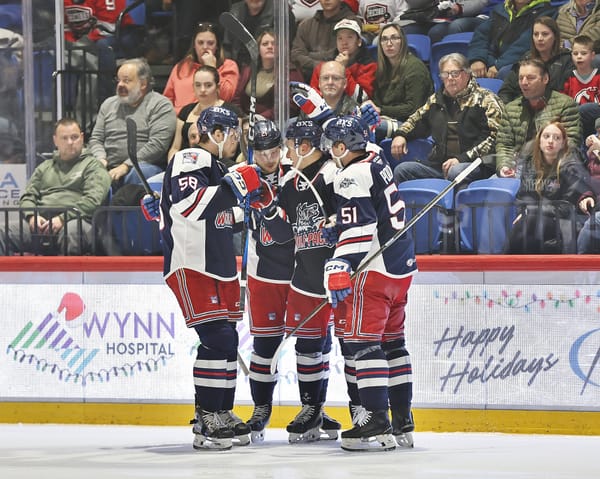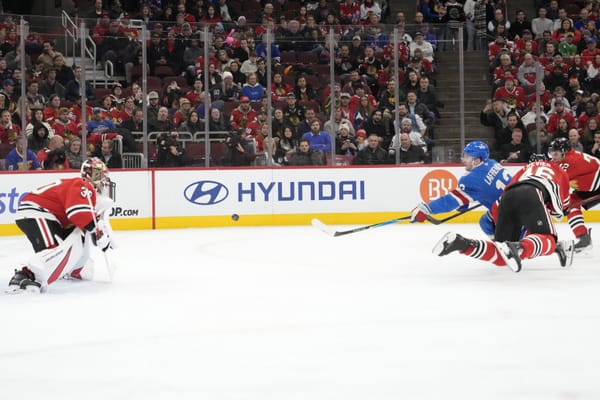Brendan Smith: a man without a role
What comes next for the fourth line winger/versatile defenseman?
When Brendan Smith was 15 he regularly played wing for the Toronto Marlboros, a minor midget team in the Greater Toronto Hockey League. He skated on a stacked line with John Tavares and Sam Gagner, and won a championship. Smith moved to a more permanent role on the blue line over the next two years with the St. Michael’s Buzzers before beginning his collegiate career on the blue line of the University of Wisconsin.
You know the rest of this story.
Smith — who signed a four-year, $17.4 million contract on June 28, 2017 to be a mainstay in the Rangers’ top four on the blue line — was spending a lot of time at wing before Libor Hajek left the Rangers lineup with an injury. Needless to say, Smith’s role with the Rangers would have been nearly impossible to predict when the Rangers acquired him at the 2017 trade deadline.
After an awful 2017-18 season, Smith was hungry to rebound in his first year under head coach David Quinn. However, the logjam on the Rangers’ blue line this year made it hard for Smith to carve out a role despite the fact that his underlying numbers have been solid. In mid-February, Smith began taking shifts in practice at left wing. Since then, he’s been taking a significant number of shifts at forward.
“It might be easier to just play one position the whole game, but I want to play minutes, and whatever I can do to help the team win, that’s ultimately the goal.” - Brendan Smith on switching between forward and D. pic.twitter.com/3rtoDXRJ4c
— New York Rangers (@NYRangers) February 16, 2019
Smith is at the stage of his career where he’s going to accept whatever role gets him on the ice. Unfortunately, he’ll never escape the shadow of his $4.35 million cap hit. If anything, that shadow is likely growing darker and taller with each shift he skates at left wing instead of on the blue line as the 2018-19 season continues to wind down.
A few days ago, Tom Urtz Jr offered his take on Larry Brooks’ suggestion that the Rangers could look to buy out Kevin Shattenkirk if his play didn’t dramatically improve. In that piece, Tom mentioned that Smith was a better buy-out candidate than Shattenkirk, and it’s hard to argue against that given what Shattenkirk’s underlying numbers look like.
Those two players are Marc Staal (age 32, $5.7 million for two more seasons) and Brendan Smith (age 30, $4.35 million for two more seasons). Smith, like Shattenkirk, is someone who I could see drawing interest from other teams if some salary were retained. His usage lately has been curious, and I wonder if that has been the Rangers way of trying to showcase his versatility. This is not to make light of his numbers, but all things considered he still has some value that can be salvaged.
It’s challenging to project what Smith’s value on the trade market is because of how he’s been used this season and how often he’s been kept out of the lineup.
His ability to play the left and right side on the blue line as well as play forward is definitely an upside, but that is more of a silver lining than a true positive trait. The bottom line here is that Smith is far better and more valuable to his team when he’s playing defense.
For a moment, let’s look at Smith the defenseman.
Smith’s -0.34 GAR (goals above replacement via Evolving-Hockey) at even strength is the worst among Rangers’ defensemen this season, although it’s difficult to measure how the significant number of shifts he’s skated as a fourth line forward may have impacted that number. The same can be said of almost all of Smith’s underlying numbers, including his -0.2 xGF% per 60 (on-ice expected goal differential per 60 minutes), which ranks fifth among Blueshirt defenders. Those numbers aren’t exactly encouraging, but when Smith is on the ice the Rangers do enjoy more control over the shot share. His 3.72 Rel CF% is second only to Shattenkirk (excluding the small sample size of Hajek) — although that likely has something to do with Shattenkirk being the skater Smith has shared the most 5v5 ice time with.
A lot of Smith’s numbers from this season don’t really jump off the page, but he’s playing much better hockey this year. Smith’s shot share numbers are greatly improved from last season and he’s also taken far fewer penalties while playing a more physical game (measuring by hits).
Another interesting dimension to Smith’s defensive game is his ability to prevent controlled zone entries. Corey Sznajder’s zone entry and exit data ranks Smith’s defense of zone entries very favorably over the last three seasons. In the viz below, created from Szajder’s data by CJ Turtoro, you can see just how exceptional Smith is when it comes to this specific, but crucial aspect of defense in the modern game.
The bottom line here is that Smith is much more than a sixth or seventh defenseman — and he’s far more valuable than a fourth line winger. However, there’s little reason to expect he’ll finish the season any higher on Quinn’s depth chart than he is right now. Despite playing a style of hockey that feels like it should appeal to Quinn’s approach, Smith has been a healthy scratch more than any other Ranger this season.
Smith and the $4.35 million average annual value of his contract are in New York for the next two seasons, which means he’ll become an unrestricted free agent just before the Seattle expansion draft. So, if Jeff Gorton wants to part ways with the versatile defenseman he’ll either have to buy him out or move him to one of the 15 teams that are on Smith’s trade list before July 1. After July 1 passes, Smith’s trade list shrinks to 10 teams for the final two years of his contract.
In other words, it would be no small task to find a buyer for Smith. Gorton and the Rangers would be selling low to a small pool of teams. So, what does this mean for Smith and his future in New York? The most likely answer to that question is that Quinn, Gorton, and the rest of the front office aren’t entirely sure just yet.
Showcasing Smith in the final 13 games of the regular season might be the best path forward from Gorton’s perspective, but that might not mesh with Quinn and his philosophy on coaching this team. With so few games left and with Hajek out for the time being, Smith needs to be his own best advocate with his play in games, his presence in the locker room, and his effort in practice. These very well could be the most crucial 13 games of his NHL career.
All salary information courtesy of CapFriendly.com. Data courtesy of naturalstattrick.com, evolving-hockey.com, and Corey Sznajder.




